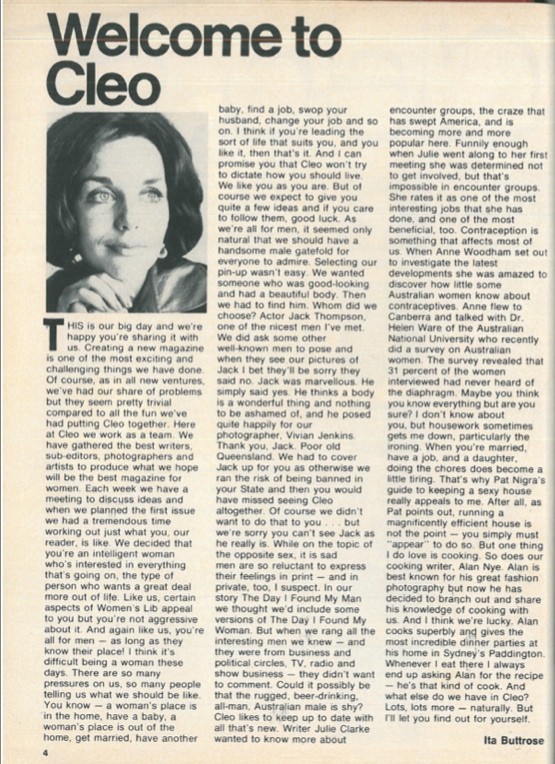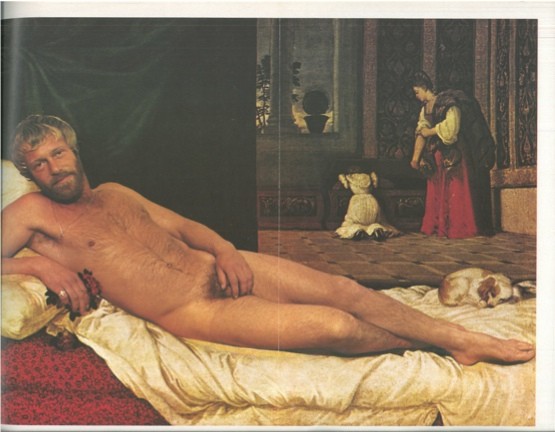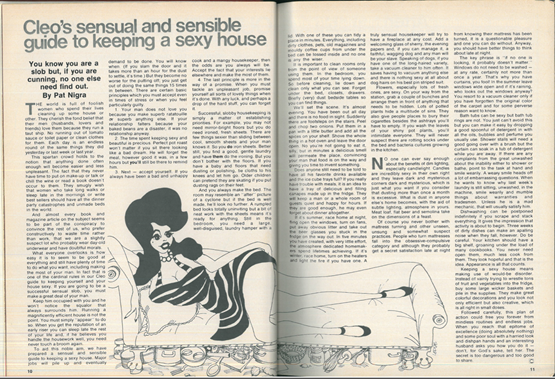How to keep a sexy home, what men are really scared about, how 30 leading Australian women met their husbands, and, of course, a nude centrefold of actor Jack Thompson. In November 1972, Cleo’s first issue was a sell-out. But circulation has been falling for years, and its last issue will be printed next month.
Cleo was never supposed to exist. ACP had been fighting for the rights to print an Australian edition of Cosmopolitan, but lost them at the last minute to rival publisher Sungravure. Ita Buttrose and Kerry Packer decided to instead launch Cleo before Cosmopolitan launched, to spoil the now-rival title.
In her first editor’s letter, Buttrose described Cleo as appealing to:
“… an intelligent woman who’s interested in everything that’s going on, the type of person who wants a great deal more out of life.
“Like us, certain aspects of Women’s Lib appeal to you but you’re not aggressive about it. And again like us, you’re all for men — as long as they know their place!”

Women’s liberation, or second-wave feminism, was overturning how women saw themselves. Cleo was a gateway to a new model of Australian womanhood — less demure, more independent, and far more forthright about sex.
When Cleo launched, men’s magazines had for decades featured pin-up girls. Cleo did the same with its infamous centrefold. While originally intended as a one-off, the “Mate of the Month” struck such a chord that Kerry Packer pushed the team into making it a regular feature, until editor Lisa Wilkinson canned it 13 years later, replacing it with the Cleo Bachelor of the Year.
A nude male centrefold wasn’t an entirely novel idea. Earlier that same year Cosmopolitan had done the same in the United States, featuring a nude Burt Reynolds on a bearskin rug in its April 1972 issue. It sold 1.6 million copies — the entire print run — and the idea then spread to the UK, where British Cosmopolitan convinced Paul du Feu to strip off for its launch issue.
While the image used by British Cosmo had been printed in Australia (by Pol magazine), Cleo was the first Australian magazine to produce its own “handsome male gatefold for everyone to admire”.

Thompson is quoted in the issue on why he chose to do the shoot. “I said ‘yes’ because I saw no reason to say no,” he told the magazine. “It’s like asking me to do a picture with a cat on my head. It’s unusual — but so what.”
Thompson’s devil-may-care response notwithstanding, the spread was risky. Cleo’s later centrefolds would feature more naturalistic scenery, but for the first issue, Thompson was pictured in the pose of Titian’s Venus of Urbino, with his hand covering his penis — the high art homage perhaps helped counter accusations of pornography. The accompanying feature stated:
“One of the lovely side effects of this age of permissiveness is that women are learning to admit their sexuality just as frankly as men have been doing ever since they first clubbed us and dragged us unconscious to their caves. The old double standard applies to nudity as well as sexual mores … Perhaps the day will come when the walls of typing pools, the kitchens and laundries of the world will be decorated with glossy, living colour pictures of nubile naked males.”
In Queensland, the Literature Board of Review wasn’t prepared to allow the magazine in. In her autobiography, Buttrose writes:
“Without even seeing our proposed centrefold, the Board decided it sounded a bit risque and doubted Jack’s hand was up to the job. To keep them happy we put a slightly larger, elegant gold square over Jack’s hand — there was no chance that anybody could possibly glimpse what was underneath.
“Fortunately, the women of Queensland didn’t feel deprived — Cleo sold out there too.”
Cleo, Buttrose wrote, “wrote about sex as though we had discovered it”. For example, here’s an article about sexy house-keeping from the first issue (click for a larger version) …
“The world is full of foolish women who spend their lives cleaning up some house or other. They cherish the fond belief that their man … loves them because they run a taut ship … This spartan crowd holds to the notion that anything done often enough will become easier and less unpleasant. The fact they never have time to put on make-up or talk or chill the wine or read a book doesn’t occur to them”.
The piece offers numerous tips on how to achieve the appearance of order with minimal effort. Crikey’s favourite tip: “If you have a baby and floors that need dusting or polishing, tie clothes to his knees and let him go.”
Another piece explored the reality of men and women living together before marriage, interviewing five couples who did so. While the men and women had largely positive things to say about the experience, most still harboured some measure of unease about going public. As Cleo’s journalist noted at the end:”All five couples still have some hang-up about not being married. None of them would let us use their real names, for fear of reaction from parents or employers. And only one couple would consider being photographed. So maybe doing your own thing is still a little underdone.”
Observational features were a key part of Cleo’s early issues. For one feature in the first issue Cleo sat five men down with a tape recorder and asked them what made them afraid — the magazine printed the transcript of their discussion.
While for the most part today’s standards are more liberal than those at the time Cleo was launched, it’s hard to see some articles being published today. For example: “Men are proper bastards” explored why, well, men are so awful. Numerous high-achieving women were interviewed about how the men in their lives were selfish, lecherous, spoilt and jealous, but the piece stopped well short of the radical solutions some feminists were advocating at the time.
“We all seem to agree that men ARE bastards in one way or another. But the fact remains that we’re stuck with them, and if we can’t change them (which seems impossible anyway) we’ll just have to grin and bear it. Good luck!”









First visit to Bali as a country soul surfer in 75, my wife and I were taken aside by immigration and amid much discussion by the various wayans and ketuts, my wife’s Cleo was confiscated.
Like Playboy & its ilk, the demise is long overdue.
Living in a household with 4 women of descending ages exposed me to quite a few Cleos & Cosmos. While the sealed sections of Cosmo were often good for a laugh, the usual content of both mags made me despair for the sanity of the women who read them. You’d have pages decrying
“fat-shaming” or some similar bs, and the next page advertising weight loss techniques and how the rich and famous stay thin. Then you’d have an article on why men are bastards and a follow up on how to please men in the boudoir. Made me feel more relaxed about reading the odd editions of FHM or Ralph (RIP).
The pity is that its demise, like that of Playboy & ilk, was so long overdue.
Sorry for the repeat – lighting strike power outage so I thought the comment lost.